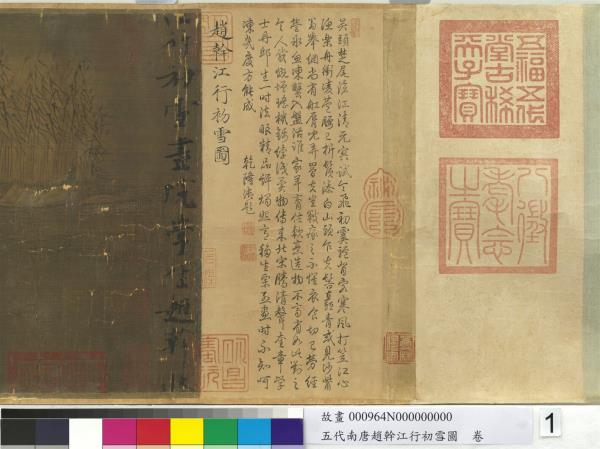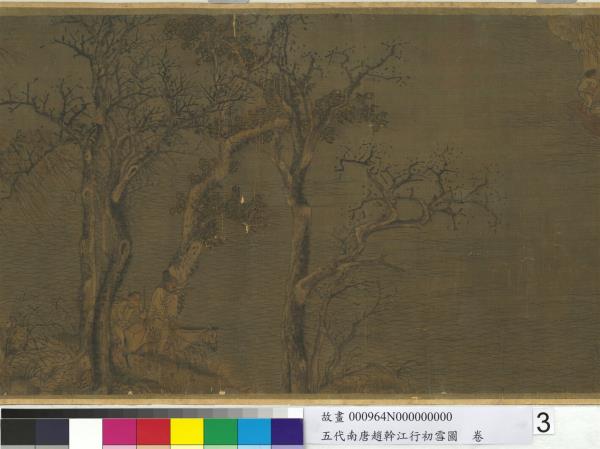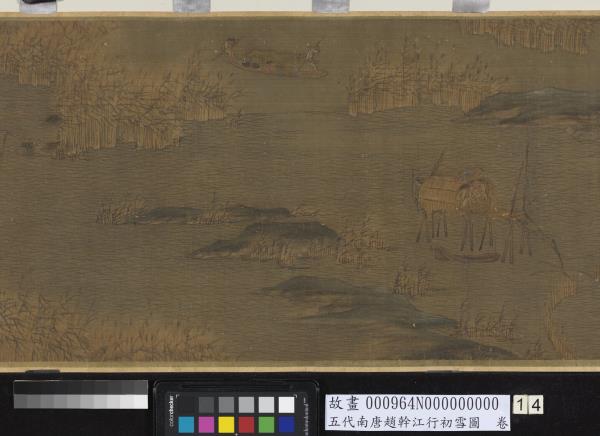| 文物統一編號 |
故畫000964N000000000
|
| 作品號 |
故畫00096400000 |
| 品名 |
五代南唐趙幹江行初雪圖 卷
Early Snow on the River |
| 分類 |
繪畫 |
| 作者 |
趙幹,Zhao Gan |
| 數量 |
一卷 |
| 位置 |
尺寸(公分) |
| 本幅 |
25.9x376.5 |
| 後隔水 |
26.2x12.4 |
| 拖尾 |
26.3x90.2 |
| 前隔水 |
26.7x12.3 |
| 質地位置 |
質地 |
| 拖尾 |
紙 |
| 本幅 |
絹 |
| 前隔水 |
綾 |
| 後隔水 |
綾 |
| 題跋類別 |
作者 |
位置 |
款識 |
書體 |
全文 |
| 作者款識 |
趙幹 |
本幅 |
|
|
江行初雪。畫院學生趙幹狀。 |
| 題跋 |
清高宗
印記 expand_more
|
前隔水 |
|
行書 |
吴頭楚尾滄江清。元冥試令飛初霙。驢背客寒風打笠。江心漁樂舟衝凌。蘆腰已折鬚添白。山頭乍失髻矗青。或見沙觜翁舉網。尚有舡脣兒弄罾。夫豈皸瘃之不懼。衣食切已勞經營。冰魚凍蟹入盤活。誰家羊膏佐軟烹。造物不齊有如此。對之令人感慨增。瑤機錦綍識異物。傳來北宋騰清聲。奎章學士丹邱生。一時法眼精品評。燭照意移生栗烈。畫時不知呵凍㡬度方能成。乾隆御題。 |
|
|
| 題跋 |
|
前隔水 |
|
|
趙幹江行初雪圖 |
| 題跋 |
清高宗
印記 expand_more
|
拖尾 |
|
|
養心殿三希堂清玩真蹟 |
|
|
| 題跋 |
|
拖尾 |
|
|
天曆二年一十日進入。奎章閣學士院典籤。臣張景先。奎章閣學士院參書。文林郎。臣柯九思。奎章閣學士院參書。奉訓大夫。臣雅琥。奎章閣供奉學士承德郎。臣李訥。奎章閣供奉學士。中議大夫。臣沙刺班。奎章閣承制學士。奉訓大夫。臣李泂。奎章閣承制學士。朝散大夫。中書左司郎中。臣朵來。奎章閣侍書學士。翰林直學士。中奉大夫。知制誥。同修國史。兼經筵官。臣虞集。奎章閣侍書學士。資善大夫。中書右丞。臣撒迪。奎章閣大學士。光祿大夫。中書平章政事。知經筵事。臣趙世延。奎章閣大學士。光祿大夫。知經筵事。臣忽都魯都兒迷失。 |
| 題籤 |
清高宗
印記 expand_more
|
|
|
|
趙幹江行初雪圖。神品。內府秘玩。 |
|
|
| 印記類別 |
印主 |
印記 |
| 收傳印記 |
|
(半印漫漶不可識) |
| 收傳印記 |
金章宗 |
內殿珍玩 |
| 收傳印記 |
元文宗 |
天曆之寶 |
| 收傳印記 |
明內府印 |
司印(半印) |
| 收傳印記 |
安岐 |
安岐之印 |
| 收傳印記 |
安岐 |
安儀周家珍藏 |
| 收傳印記 |
梁清標 |
冶溪漁隱 |
| 收傳印記 |
吳瑞徵 |
吳仲庚 |
| 收傳印記 |
吳瑞徵 |
吳瑞徵印(重一) |
| 收傳印記 |
金章宗 |
明昌 |
| 收傳印記 |
金章宗 |
明昌御覽 |
| 收傳印記 |
金章宗 |
明昌寶玩 |
| 收傳印記 |
柯九思 |
柯九思印 |
| 收傳印記 |
梁清標 |
家在北澶 |
| 收傳印記 |
金章宗 |
祕府 |
| 收傳印記 |
金章宗 |
御府寶繪 |
| 收傳印記 |
安岐 |
朝鮮人 |
| 收傳印記 |
金章宗 |
群玉中祕 |
| 收傳印記 |
梁清標 |
蒼巖子 |
| 收傳印記 |
梁清標 |
蕉林梁氏書畫之印 |
| 收傳印記 |
梁清標 |
蕉林鑑定(重一) |
| 鑑藏寶璽 |
清高宗 |
八徵耄念之寶 |
| 鑑藏寶璽 |
清高宗 |
八徵耄念之寶(半印) |
| 鑑藏寶璽 |
清高宗 |
三希堂 |
| 鑑藏寶璽 |
清內府印 |
三希堂精鑑璽 |
| 鑑藏寶璽 |
清高宗 |
三希堂精鑑璽 |
| 鑑藏寶璽 |
清高宗 |
五福五代堂古稀天子之寶(重一) |
| 鑑藏寶璽 |
清高宗 |
太上皇帝之寶 |
| 鑑藏寶璽 |
清高宗 |
孔顏樂處誰尋得 |
| 鑑藏寶璽 |
清高宗 |
古希天子(重一) |
| 鑑藏寶璽 |
清高宗 |
石渠寶笈 |
| 鑑藏寶璽 |
清內府印 |
宜子孫 |
| 鑑藏寶璽 |
清高宗 |
宜子孫 |
| 鑑藏寶璽 |
宣統帝 |
宣統御覽之寶 |
| 鑑藏寶璽 |
清高宗 |
乾隆御覽之寶 |
| 鑑藏寶璽 |
清高宗 |
乾隆鑑賞 |
| 鑑藏寶璽 |
清高宗 |
菑畬經訓 |
| 鑑藏寶璽 |
清仁宗 |
嘉慶鑑賞 |
| 鑑藏寶璽 |
清高宗 |
壽 |
| 鑑藏寶璽 |
清高宗 |
養心殿寶 |
| 鑑藏寶璽 |
清高宗 |
羲皇上人我不為 |
| 主題類別 |
主題(第一層) |
主題(第二層) |
主題說明 |
| 主要主題 |
人物 |
漁夫、船夫 |
漁夫 |
| 主要主題 |
山水 |
|
|
| 主要主題 |
船 |
漁船 |
|
| 主要主題 |
樹木 |
楊柳 |
|
| 次要主題 |
走獸 |
騾.驢 |
|
| 次要主題 |
花草 |
蘆葦 |
|
| 次要主題 |
翎毛 |
鸕鷀 |
|
| 其他主題 |
人物 |
行旅 |
|
| 其他主題 |
人物 |
侍從(侍女、童僕) |
侍從 |
| 其他主題 |
山水 |
江河、湖海 |
江河 |
| 其他主題 |
建築 |
橋 |
|
| 其他主題 |
船 |
|
|
| 其他主題 |
器用 |
耕織漁獵 |
漁(網);罟 |
| 其他主題 |
樹木 |
|
|
| 其他主題 |
樹木 |
寒林.枯樹 |
枯樹 |
| 技法 |
技法細目 |
| 人物衣紋描法(粗細線條) |
|
| 皴法 |
|
| 寫意 |
|
| 類別 |
參考資料 |
| 內容簡介 |
趙幹,南唐時江寧人。為南唐後主畫院學生。山水多作江南景,畫樓、觀舟船、水村、漁市、花、竹。論者謂其深得浩渺之意,無一點朝市風埃。畫江邊漁作,旅客攢行。樹皆中鋒圓筆,遒勁有如屈鐵,樹幹以乾筆皴染,大似後人皴山,自具陰陽向背。所畫蘆花,以赭墨裹粉,一筆點成,小丘及坡腳,亦以淡墨成塊塗抹而無皴紋,皆與後人異趣,人驢面目,並有苦寒之色。
|
| 內容簡介 |
本畫為現存最可信的五代南唐畫蹟之一,上有傳為李後主的題識,指明作者為畫院畫家趙幹。全畫描繪南方江邊行旅所見漁人生活,時瑞雪初降,蕭瑟之中仍可見庶民活動的和樂勤奮。這種風俗畫既是紀實,也有理想化的成份。本卷原為金章宗收藏。一三二九年由奎章閣諸臣共同呈進,文宗並在幅中親書神品上的評第。他的品題表示宮廷對中原傳統的收納,也形塑著自己的藝術帝王形象。
|
| 內容簡介 |
「江行初雪圖」是一幅山水人物並重的繪畫作品,也是傳世作品中時代很早的一幅絹地山水畫。畫家趙幹,江蘇江寧人,南唐李後主在位時,為畫院學生。自小生長在江南,因而所畫山水多為江南景物,尤其擅長佈景。在這幅手卷中,畫家就利用彎曲的黃蘆堤岸,構置出浩渺的水波江面。畫中寒雪紛飛,江邊漁人為了生計得繼續頂著風雪幹活,備極艱辛。而行走在岸邊的旅客,同樣冒著寒雪趕路,人、驢皆帶著一付苦寒難行的面目,畫家藉著筆下人物的表情,反映出畫中寒凍的江天。全幅淡墨漬染絹地,再灑白粉為雪。寒林枯木皆用中鋒圓筆,勁挺有力。樹幹以乾筆皴染,自具陰陽向背。所畫蘆花,以赭墨裹粉,一筆點成,極富創意。小丘及坡腳,也以淡墨成塊塗抹而無皴紋。本幅上鈐有金、元、明、清各朝內府收藏印,足證此卷為一件流傳有緒的精品。
|
| 內容簡介 |
南唐與後蜀的畫院是宋朝成立前畫壇的重鎮,也是構成北宋宮廷繪畫的主力。趙幹任職南唐畫院,本卷起首處之題字,一說為後主李煜手筆,更增此作在畫史上之重要性。 冬日江邊行旅所見漁家活動是本卷的主題。這本是作為帝王體察民風之用的「風俗畫」,但趙幹在畫中又刻意地描繪了各種漁人造型、漁撈方式,並以瑟縮身軀的童子與垂首逆風而行的驢子等細節,來營造一種更具臨場感的視覺效果。(20061206)
|
| Description |
The painting academies established at the courts of the Southern T'ang and the Latter Shu were important precedents for the foundation of the Painting Academy in the following Sung dynasty, constituting a major force in the development of Northern Sung court painting. Chao K’an served in the Southern T'ang Painting Academy. The beginning of this handscroll at the right bears an inscription said to have been written by Li Yu (Li Hou-chu), the last ruler of the Southern T'ang, further adding to the importance of this work in the history of Chinese painting. The activities of fishermen form the main theme of this handscroll of travel scenery taking place by a riverside. As a “genre painting”, this work was probably done for the purpose of allowing the emperor to examine the life of common folk. However, this does not diminish its artistic merit, for Chao Kan intentionally rendered the fishermen in various manners and the details of fishing methods. He also used such details as the withdrawn shivering of the attendant and the donkey with head down making its way against the wind to create a strong visual effect of bitter cold and actually being there.(20061206)
|
| Description |
This authentic early landscape painting on silk also includes vivid descriptions of figures. The Southern T’ang ruler Li Yu (r. 961-975) at the beginning of the scroll to the right wrote, “Early Snow on the River by Student Chao K'an of the Southern T'ang,” providing contemporary proof of both the title and artist. Chao K'an was a native of Kiangsu province who spent his life in the lush Kiangnan area. Not surprisingly, his landscape painting here shows the water-filled scenery typical of the area. Unrolling this scroll from right to left shows the activities of fishermen zigzagging among isolated expanses of water. Despite the falling snow, fishermen continue to toil away to make a living. Travelers on the bank also make their way in the snow, the artist showing the bitter cold through the expressions on their faces. The bare trees and dry reeds only add to the desolation of the scene. Chao K'an sprayed dots of white color for a realistic effect to suggest wind-driven flakes of snow. Chao K'an's centered brushwork outlining the bare trees is also powerful, and the tree trunks were textured with dry strokes to suggest light and dark. Chao also creatively depicted the reeds using single flicks of the brush, and he modeled the land forms without using formulaic strokes. The history of the seal impressions indicates that this masterpiece was treasured in both private and imperial collections starting from the Sung dynasty (960-1279).
|
| Description |
Chao Kan (fl. 10th cent.) served in the Imperial Painting Academy of Li Hou-chu, the last ruler of the Nan-t’ang dynasty. His landscapes depict the scenery of Kiangnan. In painting buildings, monasteries, boats, riverside hamlets, fishing villages, flowers and bamboo, it is said that he deeply expressed the boundless sentiment of nature without the slightest trace of urban taint. The landscape depicts fishermen on a river, with some travelers wending their way along a path. The trees were all painted with an upright brush, giving them a strength similar to bent steel. Chao Kan's use of dry-brush strokes and washes to paint the trunks of the trees is similar to the technique used by later artists in rendering mountains. The faces of figures and mules reflect the biting cold.
|
| 收藏著錄 |
石渠寶笈初編(隨安室),下冊,頁1178
|
| 收藏著錄 |
故宮書畫錄(卷四),第二冊,頁 17
|
| 收藏著錄 |
故宮書畫圖錄,第十五冊,頁153-160
|
| 參考書目 |
1.胡賽蘭,〈五代南唐趙幹江行初雪圖〉,收入王耀庭、許郭璜、陳階晉編,《故宮書畫菁華特輯》(臺北:國立故宮博物院,1987年初版,2001年再版),頁54-57。
2.〈五代趙幹江行初雪〉,收入劉芳如主編,《書畫裝池之美》(臺北:國立故宮博物院,2008年初版一刷),頁154。
3.陳韻如,〈五代南唐趙幹江行初雪圖 卷〉,收入林柏亭主編,《大觀-北宋書畫特展》(臺北:國立故宮博物院,2006年初版一刷),頁130-135。
4.陳韻如,〈趙幹江行初雪圖〉,收入石守謙、葛婉章主編,《大汗的世紀:蒙元時代的多元文化與藝術》(臺北:國立故宮博物院,2001年初版),頁289。
5.童文娥,〈江行初雪〉,收入林柏亭主編,《國寶菁華 — 書畫‧圖書文獻篇》(臺北:國立故宮博物院,2006年12月),頁194。
6.胡賽蘭,〈國之重寶 — 書畫精萃特展〉,《故宮文物月刊》,第19期(1984年10月),頁19-20。
7.本社,〈南唐趙幹江行初雪〉,《故宮文物月刊》,第69期(1988年12月),頁1。
8.胡賽蘭,〈五代南唐趙幹江行初雪圖〉,《故宮文物月刊》,第100期(1991年7月),頁71。
9.陳韻如,〈行走於蒙元的藝廊裡 — 「大汗的世紀」特展 五代南唐趙幹江行初雪〉,《故宮文物月刊》,第225期(2001年12月),頁18-19。
10.李霖燦,〈山水畫中點景人物的斷代研究〉,《故宮季刊》,第十三卷第二期(1978年冬),頁25-40。
11.梁麗祝,《南唐趙幹江行初雪圖之研究》,中國文化學院藝術研究所碩士論文,1987年。
12.陳階晉,〈五代南唐趙幹江行初雪圖〉,收入蔡玫芬主編,《精彩一百 國寶總動員》(臺北:國立故宮博物院,2011年九月初版一刷),頁244。
|
| 網頁展示說明 |
此卷為一件重要的早期山水人物畫作,畫江南初雪,霜寒蕭瑟,江邊漁民的生活景況,岸上尚有行旅縮瑟前進,畫中人物描繪精微,傳神生動。通幅以淡墨漬染絹地,筆力遒勁,樹石具陰陽向背,其技法之高妙與描繪之精細皆令人讚歎。卷首有「江行初雪畫院學生趙幹狀」題字,後世據此定名,近有學者認為此卷與北宋晁補之《雞肋集》中王維〈捕魚圖〉描繪吻合,指出或與北宋所認知的王維有關。(20110913)
|
| 網頁展示說明 |
This handscroll is an important early painting of landscape and figures. Depicting an early snow in the Jiangnan region, a frigid cold pierces the air. With scenery of life among fishermen along the river, on the banks are travelers making their way huddled against the cold, the figures in the painting depicted with great refinement and lively realism. The light ink and washes on the silk ground throughout the painting reveal the force of strong brushwork, and trees and rocks reveal shading, the marvels of Zhao’s technique and the refinement of his painting still as amazing as ever. At the beginning of the scroll is an inscription for “Painting of ‘Early Snow on the River’ by the Student Zhao Gan.” Later generations have followed this title, but recent scholars believe that this scroll accords with the painting “Catching Fish” by Wang Wei found in Collection of Trifling Matters by Chao Buzhi of the Northern Song, pointing out that it may be related to what people in the Northern Song considered Wang Wei’s style to be.(20110913)
|
| 參考書目 |
陳韻如,〈五代南唐趙幹江行初雪圖 卷〉,收入陳韻如主編《公主的雅集-蒙元皇室與書畫鑑藏文化特展》(臺北:國立故宮博物院,2016.10),頁64-77、263-264。
|
| 參考書目 |
國立故宮博物院編輯委員會,〈五代南唐趙幹江行初雪圖 卷〉,收入《故宮書畫菁華特輯》(臺北:國立故宮博物院,1996.10),頁54-57。
|
本院文物保存維護依〈國立故宮博物院典藏文物管理作業要點〉及〈國立故宮博物院文物修護業務作業原則〉辦理
抽盤點紀錄
修護紀錄







































































